Text
Triton: The Odd One Out
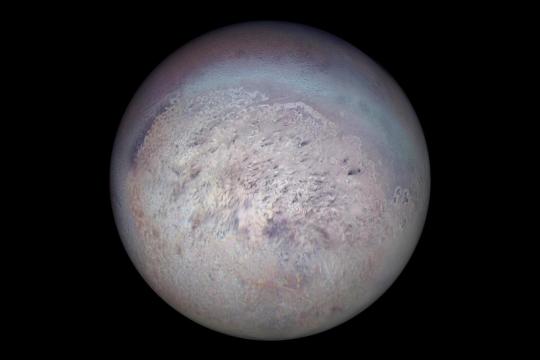

Despite its distance from the Sun, Neptune holds one of the most interesting objects in the Solar System within its gravitational grasp: the moon Triton. What makes Triton truly unique is that it's the only large moon in our solar system that orbits its planet in a direction opposite to the planet's rotation, a behavior that has mystified scientists for years. This peculiar "retrograde" orbit hints at a turbulent past, suggesting that Triton was not born with Neptune but was likely captured by the planet's immense gravity eons ago. Triton's capture may have caused tidal forces that dramatically reshaped both the moon and Neptune's moon system, leaving Triton as the last one standing after a celestial game of cosmic billiards.
Triton's formation and history are wrapped in cosmic enigma. Some researchers believe it may have been a Kuiper Belt Object, a frigid world from the distant reaches of our solar system, before being drawn into Neptune's orbit. Its surface is marked by a stunning array of features, from icy plains to towering geysers that spew nitrogen gas into the vacuum of space. The moon is chillingly cold, with temperatures plummeting to nearly absolute zero, making it one of the coldest places in our solar system.
Triton's peculiarities continue to intrigue scientists, beckoning us to unravel its secrets and ponder the mysteries of our distant, icy neighbor in the outer realms of the cosmos. As we peer into the depths of our solar system, Triton reminds us that even in the frigid darkness of the outer planets, there's always room for wonder and discovery.

1st and 3rd images are from Voyager probes, while the 2nd is from JWST (all credit to NASA obviously).
We're almost out of the solar system, stuffs gonna get real big real fast :)
1 note
·
View note
Text
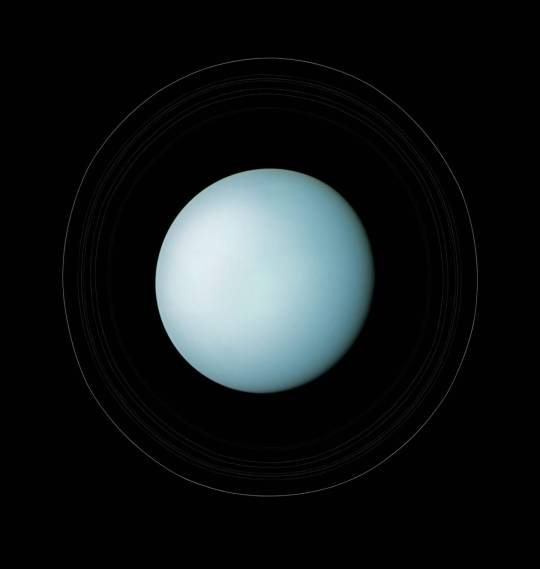

Uranus: The Haha Funny Name
Uranus, the seventh planet from the Sun, is a peculiar world that stands out from the other gas giants for several reasons. First, it's known for its unique tilt. While most planets spin on an axis roughly perpendicular to their orbits, Uranus seems to roll on its side, making it look like it's rotating almost parallel to its orbital plane. This unusual orientation has sparked countless questions among scientists, leaving them pondering the mysteries of its formation.
One of the most fascinating aspects of Uranus is its appearance. It's often described as an "ice giant" due to its composition, which includes a thick atmosphere primarily composed of hydrogen and helium, with traces of water, methane, and ammonia. These elements give Uranus its striking blue-green hue, and the presence of methane in its atmosphere is responsible for its unique color.
Probes like Voyager 2 have provided invaluable insights into this distant planet. In 1986, Voyager 2 made a historic flyby, capturing detailed images of Uranus and its moons, and revealing its strange, featureless appearance. Uranus' lack of distinct cloud bands, unlike Jupiter or Saturn, adds to its enigmatic charm. The probe's data also unveiled its icy ring system, and the discovery of 27 known moons, each with its own peculiarities.
Uranus boasts a turbulent atmosphere with high-speed winds, reaching speeds of up to 560 miles per hour (900 kilometers per hour). The planet experiences extreme seasons, each lasting about 20 Earth years, due to its extreme axial tilt. When one hemisphere faces the Sun, it basks in continuous sunlight for years, while the other is plunged into darkness. This unique weather pattern showcases the dynamic nature of Uranus, where scientists continue to explore the depths of its mysteries. Uranus remains a distant and intriguing world that challenges our understanding of planetary science, inviting us to delve deeper into the wonders of our own solar system.

1st 2 pictures taken from the NASA archives (first one is likely a simulation or model but the 2nd one is from Voyager 2). Last picture was taken by JWST
(I may have forgotten about this account for a little, but the zooming out continues now :] )
13 notes
·
View notes
Text


Saturn: Cassini's Mission
Saturn, has always intrigued astronomers and space enthusiasts alike with its potentially life-rearing moons and intricate rings. One of the most remarkable chapters in Saturn's exploration was the Cassini mission. Launched on October 15, 1997, Cassini embarked on a daring journey to study Saturn and its moons up close. After a seven-year voyage, Cassini entered Saturn's orbit on July 1, 2004, beginning its mission to unveil the secrets of this magnificent planet.
Over the course of its 13-year mission, Cassini revolutionized our understanding of Saturn and its moons. It captured breathtaking images of Saturn's iconic rings, revealing their intricate structure and composition. Cassini also provided valuable insights into the mysterious moon Titan, showcasing its hazy atmosphere and hydrocarbon lakes. The mission discovered geysers erupting from the moon Enceladus, indicating the presence of a subsurface ocean. But finally, on September 15, 2017, Cassini bid farewell to Saturn by plunging into its atmosphere, transmitting invaluable data until its final moments.
Fun Fact: Saturn is very low density, so theoretically it would float on water.
I could go on about Saturn and its rings/moons for an eternity, but I decided to focus on the Cassini mission so I could link my favorite Sleeping at Last song
Pictures taken from NASA'S Cassini mission archive
35 notes
·
View notes
Text
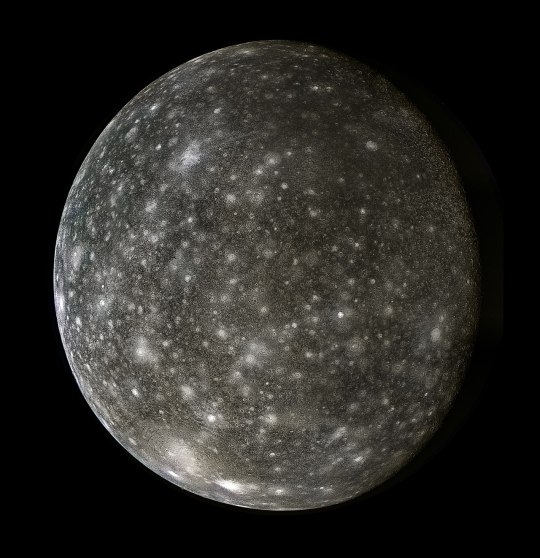
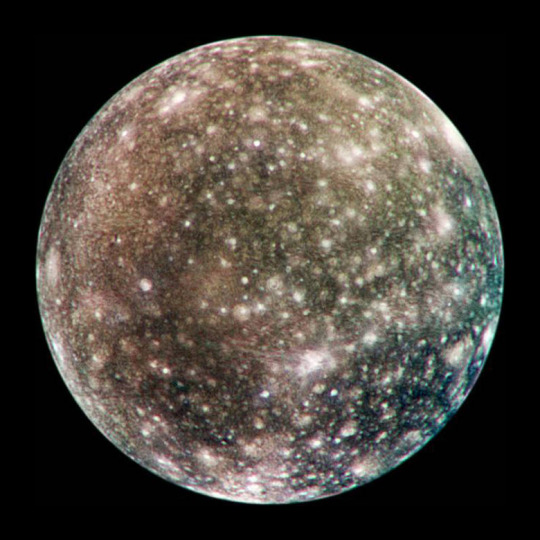
Callisto: The Namesake
As one of the Galilean moon's of Jupiter, Callisto stands in the company of some of the most wondrous and awe-inspiring worlds in our Solar System. With none of the geological activity of Io and Ganymede and no beautiful scratched terrian like Europa, Callisto can seem to be a sad little rock in the midst of superstars. But for Callisto it's majesty isn't hidden under its surface, rather it is in the open for us to see. The moon is the third largest moon in the solar system, and a majority of its surface is riddled with craters. It's lack of geological activity means these craters haven't been erased or smoothed over, leaving the surface of Callisto a long and detailed record of the history of our solar system. It's surface is widely considered the oldest in the solar system, estimated at about 4.5 billion years old. This large moon may not be a future harbor for human life as we expand into our star system, but instead remains our oldest history book and one of the best looks into the workings of the early solar system.
Fun Fact Time!
- Callisto is approximately the same size as Mercury (Though much less dense)
- Callisto is theorized to have a possible subsurface ocean, much like it's other Galilean moon members
Pictures from NASA Voyager 2 mission archives
6 notes
·
View notes
Text
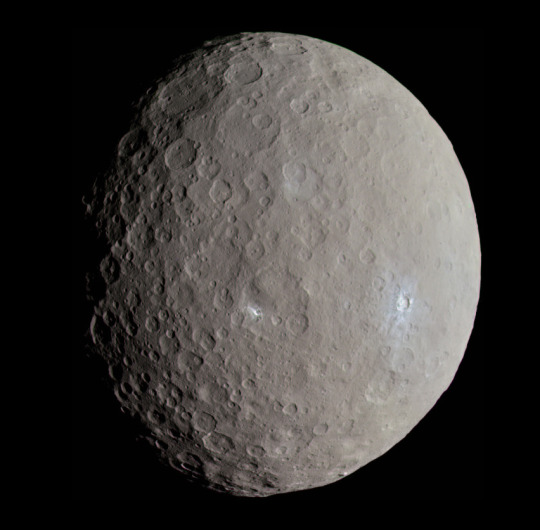
Ceres- The Queen of the Asteroid Belt
Meet Ceres, the fascinating dwarf planet residing in the asteroid belt between Mars and Jupiter. Despite its small size, Ceres holds some big surprises. It's the largest object in this vast region, containing 25% of the belt's entire mass and boasting a diameter of about 940 km (590 miles). Ceres boasts a unique blend of rocky and icy materials, making it a fascinating celestial body to study. This dwarf planet is pockmarked with countless craters, evidence of a tumultuous history shaped by cosmic collisions. But what really sets Ceres apart is its mysterious bright spots, which have puzzled scientists for years. These enigmatic patches might be signs of salty water or other intriguing substances lurking beneath its surface. Exploring Ceres might hold the key to understanding the origins of our solar system and uncovering the secrets of icy worlds.
Extra Fun Fact 1: Ceres was the first dwarf planet to be visited by a spacecraft in 2015 (even before Pluto! Pluto was visited by New Horizon's later that year)
Extra Fun Fact 2 : The entire mass of the asteroid belt is only 3% of the mass of the moon
Image sourced from Nasa's public archives
28 notes
·
View notes
Text


Luna
The moon, Earth's only natural satellite, has captivated the human imagination for millenia. Its barren, cratered surface tells a story of cosmic impacts and volcanic activity. The moon lacks an atmosphere, making it an airless world with extreme temperature variations. Its geography is marked by vast plains called "maria" (Latin for ocean) formed from ancient lava flows. These dark patches contrast greatly with the bright, rugged highlands, where mountains and deep craters dominate the landscape. The moon's most iconic feature is the massive South Pole-Aitken Basin, one of the largest impact craters in the solar system. While we know the moon holds nothing for us in terms of preexisting life, it may yet prove useful as a cosmic stepping stone to further planets of the solar system.
Both images taken by me!
1. Image using research telescope, it's really not meant for nearby objects so the moon isn't able to fit into frame. (FOV of 15")
2. Image taken on my phone through a smaller telescope piggybacking on the research telescope.
10 notes
·
View notes